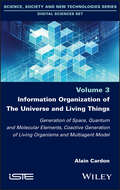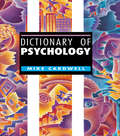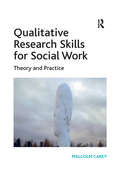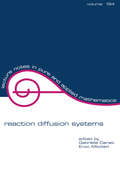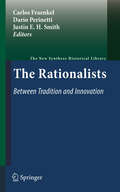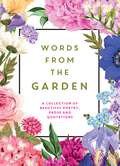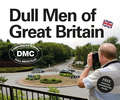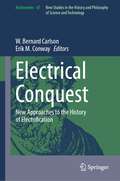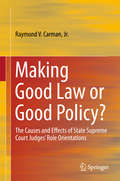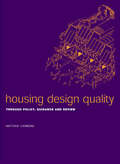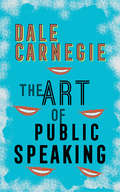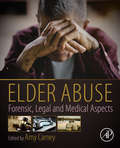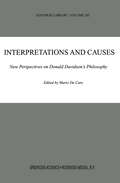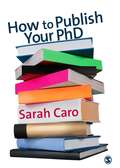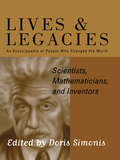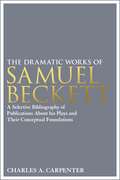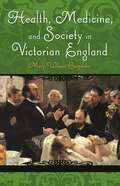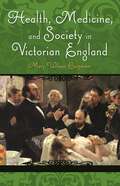- Table View
- List View
Information Organization of the Universe and Living Things: Generation of Space, Quantum and Molecular Elements, Coactive Generation of Living Organisms and Multiagent Model
by Alain CardonThe universe is considered an expansive informational field subjected to a general organizational law. The organization of the deployment results in the emergence of an autonomous organization of spatial and material elements endowed with permanence, which are generated on an informational substratum where an organizational law is exercised at all scales. The initial action of a generating informational element produces a quantity of basic informational elements that multiply to form other informational elements that will either be neutral, constituting the basic spatial elements, or active, forming quantum elements.The neutral basic elements will form the space by a continuous aggregation and will represent the substrate of the informational links, allowing the active informational elements to communicate, in order to aggregate and organize themselves.Every active element is immersed in an informational envelope, allowing it to continue its organization through constructive communications. The organizational law engages the active quantum elements to aggregate and produce new and more complex quantum elements, then molecular elements, massive elements, suns and planets. Gravity will then be the force of attraction exerted by the informational envelopes of the aggregates depending on their mass, to develop them by acquisition of new aggregates.The organizational communication of the informational envelopes of all of the physical material elements on Earth will enable the organization of living things, with reproduction managed by communications between the informational envelopes of the elements, realizing a continuous and powerful evolution.
Information Organization of the Universe and Living Things: Generation of Space, Quantum and Molecular Elements, Coactive Generation of Living Organisms and Multiagent Model
by Alain CardonThe universe is considered an expansive informational field subjected to a general organizational law. The organization of the deployment results in the emergence of an autonomous organization of spatial and material elements endowed with permanence, which are generated on an informational substratum where an organizational law is exercised at all scales. The initial action of a generating informational element produces a quantity of basic informational elements that multiply to form other informational elements that will either be neutral, constituting the basic spatial elements, or active, forming quantum elements.The neutral basic elements will form the space by a continuous aggregation and will represent the substrate of the informational links, allowing the active informational elements to communicate, in order to aggregate and organize themselves.Every active element is immersed in an informational envelope, allowing it to continue its organization through constructive communications. The organizational law engages the active quantum elements to aggregate and produce new and more complex quantum elements, then molecular elements, massive elements, suns and planets. Gravity will then be the force of attraction exerted by the informational envelopes of the aggregates depending on their mass, to develop them by acquisition of new aggregates.The organizational communication of the informational envelopes of all of the physical material elements on Earth will enable the organization of living things, with reproduction managed by communications between the informational envelopes of the elements, realizing a continuous and powerful evolution.
Dictionary of Psychology
by Mike CardwellFirst Published in 2001. Routledge is an imprint of Taylor & Francis, an informa company.
Dictionary of Psychology
by Mike CardwellFirst Published in 2001. Routledge is an imprint of Taylor & Francis, an informa company.
Qualitative Research Skills for Social Work: Theory and Practice
by Malcolm CareyMalcolm Carey provides social work students, academics and practitioners with a practical guide to completion of a small-scale qualitative research project or dissertation. This clear text takes the reader through the process of beginning and developing a research problem or question, defining their objectives and undertaking empirical or literature-based research that involves data collection, analysis, writing up and dissemination. The book also highlights and details potential obstacles, essential techniques and methods, types of theory and methodology used, and presents case studies and ongoing debates involved in qualitative social work research. It suggests ways by which sometimes difficult processes (such as the literature review, interviews with practitioners, etc.) can be made easier to complete and explores traditional methods such as the focus group or interview alongside less conventional methodologies such as participative, narrative, discourse or ICT-related approaches. Recent investigation has highlighted the lack of research skills held by many social workers in practice. This book overcomes these problems by providing an essential and easily accessible guidebook to qualitative research methods for social work students and practitioners as well as being of interest to tutors who teach research methods to social work students or supervise dissertations.
Qualitative Research Skills for Social Work: Theory and Practice
by Malcolm CareyMalcolm Carey provides social work students, academics and practitioners with a practical guide to completion of a small-scale qualitative research project or dissertation. This clear text takes the reader through the process of beginning and developing a research problem or question, defining their objectives and undertaking empirical or literature-based research that involves data collection, analysis, writing up and dissemination. The book also highlights and details potential obstacles, essential techniques and methods, types of theory and methodology used, and presents case studies and ongoing debates involved in qualitative social work research. It suggests ways by which sometimes difficult processes (such as the literature review, interviews with practitioners, etc.) can be made easier to complete and explores traditional methods such as the focus group or interview alongside less conventional methodologies such as participative, narrative, discourse or ICT-related approaches. Recent investigation has highlighted the lack of research skills held by many social workers in practice. This book overcomes these problems by providing an essential and easily accessible guidebook to qualitative research methods for social work students and practitioners as well as being of interest to tutors who teach research methods to social work students or supervise dissertations.
Reaction Diffusion Systems
by Gabriela Caristi"Based on the proceedings of the International Conference on Reaction Diffusion Systems held recently at the University of Trieste, Italy. Presents new research papers and state-of-the-art surveys on the theory of elliptic, parabolic, and hyperbolic problems, and their related applications. Furnishes incisive contribution by over 40 mathematicians representing renowned institutions in North and South America, Europe, and the Middle East."
eHealth: Legal, Ethical and Governance Challenges
by Carlisle George, Diane Whitehouse and Penny DuquenoyThis publication identifies and discusses important challenges affecting eHealth in the EU and North America in the three areas of law, ethics and governance. It makes meaningful contributions to the eHealth discourse by suggesting solutions and making recommendations for good practice and potential ways forward. Legal challenges discussed include issues related to electronic medical records, telemedicine, the Internet and pharmaceutical drugs, healthcare information systems and medical liability. Ethical challenges focus on telehealth and service delivery in the home, Web 2.0 and the Internet, patient perceptions and ethical frameworks. Governance challenges focus on IT governance in healthcare, governance and decision-making in acute care hospitals, and different models of eHealth governance. The publication provides useful support materials and readings for persons active in developing current understandings of the legal, ethical and governance challenges involved in the eHealth context.
The Rationalists: Between Tradition and Innovation (The New Synthese Historical Library #65)
by Carlos Fraenkel, Dario Perinetti and Justin E. H. SmithThis volume draws a balanced picture of the Rationalists by bringing their intellectual contexts, sources and full range of interests into sharper focus, without neglecting their core commitment to the epistemological doctrine that earned them their traditional label. The collection of original essays addresses topics ranging from theodicy and early modern music theory to Spinoza’s anti-humanism, often critically revising important aspects of the received picture of the Rationalists. Another important contribution of the volume is that it brings out aspects of Rationalist philosophers and their legacies that are not ordinarily associated with them, such as the project of a Cartesian ethics. Finally, a strong emphasis is placed on the connection of the Rationalists’ philosophy to their interests in empirical science, to their engagement in the political life of their era, and to the religious background of many of their philosophical commitments.
Words From the Garden: A Collection of Beautiful Poetry, Prose and Quotations
by Isobel CarlsonThis beautiful collection of poetry and prose through the seasons rhapsodises on the spectacle of colour and everything green and flourishing in the garden. The perfect book for a moment’s reflection, whether you are cooped up on a rainy day in your potting shed or admiring the fruits of your labour on a sunny evening from the pergola.
Dull Men of Great Britain: Celebrating the Ordinary (Dull Men's Club)
by Leland CarlsonNeil collects bricks, Kevin is a roundabout enthusiast, John runs the Apostrophe Protection Society and Keith’s actual job is watching paint dry. They are members of the Dull Men’s Club and are passionate about the everyday, unglamorous things in life. They are dull and proud and urge the good ordinary men of the nation to join them now. Whether you have a thing for pylons or rhubarb, reclaim and celebrate the ordinary. Includes Free Honorary Membership.Predictable * Reliable * Safe
Electrical Conquest: New Approaches to the History of Electrification (Archimedes #67)
by W. Bernard Carlson Erik M. ConwayThis book, drawing on fresh scholarship, investigates electrification in new places and across different time periods. While much of our understanding of electrification as a historical process is based on the seminal work done by Thomas P. Hughes in Networks of Power (1983), the scholars in this volume expand and revise Hughes’ systems approach to suggest that electrification is a heterogeneous and contingent process. Moreover, the contributors suggest that the conquest of the world by electricity remains incomplete despite more than a century elapsing. Above all, though, this book provides context for thinking about what lies ahead as humans continue their conquest of the earth through electricity. As we become increasingly dependent on electricity to power our lights, heat and cool our homes, turn the wheels of industry, and keep our information systems humming, so we are ever more vulnerable when the grid runs into trouble.Chapter "Surveying the Landscape: The Oil Industry and Alternative Energy in the 1970s" is available open access under a Creative Commons Attribution 4.0 International License via link.springer.com.
Making Good Law or Good Policy?: The Causes and Effects of State Supreme Court Judges’ Role Orientations
by Raymond V. CarmanThis book uses role theory to analyze the judicial decisions made by state supreme court judges. Grounded in the fields of anthropology, business management, psychology, and sociology, role theory holds that, for each position an individual occupies in society, he or she creates a role orientation, or a belief about the limits of proper behavior. Judicial role orientation is conceptualized as the stimuli that a judge feels can legitimately be allowed to influence his or her decision-making and, in the case of conflict among influences, what priorities to assign to different decisional criteria. This role orientation is generally seen as existing on a spectrum ranging from activist to restraintist. Using multi-faceted data collection and empirical testing, this book discusses the variation in judges’ role orientations, the role that personal institutional structure and judges' backgrounds play in determining judicial orientations, and the degree to which judges’ orientations affect their decision-making. The first study to provide cross-institutional research on state supreme court judges, this book expands and advances the literature on judicial role orientation. As such, this book will be of interest to graduate students and researchers studying political science, public policy, law, and the courts.
Housing Design Quality: Through Policy, Guidance and Review
by Matthew CarmonaThis book directly addresses the major planning debate of our time - the delivery and quality of new housing development. As pressure for new housing development in England increases, a widespread desire to improve the design of the resulting residential environments becomes evermore apparent with increasing condemnation of the standard products of the volume housebuilders.In recent years central government has come to accept the need to deliver higher quality living environments, and the important role of the planning system in helping to raise design standards. Housing Design Quality focuses on this role and in particular on how the various policy instruments available to public authorities can be used in a positive manner to deliver higher quality residential developments.
Housing Design Quality: Through Policy, Guidance and Review
by Matthew CarmonaThis book directly addresses the major planning debate of our time - the delivery and quality of new housing development. As pressure for new housing development in England increases, a widespread desire to improve the design of the resulting residential environments becomes evermore apparent with increasing condemnation of the standard products of the volume housebuilders.In recent years central government has come to accept the need to deliver higher quality living environments, and the important role of the planning system in helping to raise design standards. Housing Design Quality focuses on this role and in particular on how the various policy instruments available to public authorities can be used in a positive manner to deliver higher quality residential developments.
The Art of Public Speaking
by Dale CarnegieA pioneer in the field of self-help, Dale Carnegie distilled his experiences as a salesman and lecturer in this first guide to successful speech-making. The Art of Public Speaking is direct, practical advice for emphasizing ideas for easy comprehension and high impact ranges from finding an appropriate rhythm to conquering stage fright.Avoiding the use of tricks and shortcuts, the author suggests methods for developing one's thoughts in order to form an original, authentic manner of speaking. He advises speakers to practice their presentation skills, offering useful tips for speech-making in both personal and professional situations. First published in 1915, this classic continues to encourage people from all walks of life to overcome their self-consciousness and increase their effectiveness and comfort as public speakers.Penguin Random House Canada is proud to bring you classic works of literature in e-book form, with the highest quality production values. Find more today and rediscover books you never knew you loved.
Elder Abuse: Forensic, Legal and Medical Aspects
by Amy CarneyElder Abuse: Forensic, Legal and Medical Aspects focuses on the psychological, financial and physical abuse and neglect that is widespread in elder abuse across socioeconomic levels. It provides expert information on forensic and legal topics that professionals need to understand to confront these crimes. The topics included are those most important in the detection and prosecution of elder abuse. Identification and epidemiology are discussed, as are types and presentations of abuse. Written at a level for both professionals and students who wish to gain a broader understanding of specific forensic topics in elder maltreatment, this book is an ideal source.Covers the physical, sexual, financial and psychological types of elder abuseIncludes a section on domestic violence in the elderly, as well as wound identificationProvides a multidisciplinary approach that is emphasized with special sections on death investigation, evidence collection, the medical examiner’s responsibilities, and the response of the justice system
Interpretations and Causes: New Perspectives on Donald Davidson’s Philosophy (Synthese Library #285)
by Mario De CaroMany articles and books dealing with Donald Davidson's philosophy are dedicated to the papers and ideas Davidson put forward in the `sixties and `seventies. In the last two decades, however, Davidson has continued to work in many areas of philosophy, offering new contributions, many of which are highly regarded by philosophers working in the fields concerned. For instance, Davidson has considerably developed his ideas about interpretation, theory of meaning, irreducibility of the mental, causation, and action theory; he has proposed an innovative externalist conception of the mental content and a new analysis of the concept of truth; and he has partly modified his theses about event, and the supervenience of the mental on the physical. In Interpretations and Causes, some of the leading contemporary analytic philosophers discuss Davidson's new ideas in a lively, relevant, useful, and not always entirely sympathetic way. Davidson himself offers and original contribution.
How to Publish Your PhD
by Sarah CaroHow to Publish Your PhD is the first book to provide emerging researchers with a comprehensive and authoritative guide to publishing their research. Drawing on nearly twenty years in the book business Sarah Caro explains in a clear and accessible way the key issues facing the would-be author. Within the context of today's fast changing world where new technologies and increasing globalization continue to impact on academia and the world of academic publishing, key issues are discussed ranging from whether publishing your PhD is always the best way to enhance your career prospects to whether you should focus on journals or books. A wealth of practical information and advice is included on: choosing a publisher revising your thesis putting together a proposal surviving the review process negotiating a contract working with your publishers marketing department. The book is designed to be an easy to use, one stop guide with examples, chapter summaries and further reading. It will be an invaluable resource for emerging researchers across the broadest range of the humanities and social sciences and for all those teaching and advising them, in Europe and the US. 'Every PhD student should buy a copy of How to Publish your PhD before and not after they enrol for a doctoral degree. Informative, practical and insightful, Sarah Caro will become the mentor of every successful PhD student. A mine of information and practical advice, this text is the definitive nuts-and-bolts manual on how to do it. A safe and sure guide' - Bryan S. Turner, Alona Evans Distinguished Visiting Professor, Wellesly College
How to Publish Your PhD (PDF)
by Sarah CaroHow to Publish Your PhD is the first book to provide emerging researchers with a comprehensive and authoritative guide to publishing their research. Drawing on nearly twenty years in the book business Sarah Caro explains in a clear and accessible way the key issues facing the would-be author. Within the context of today's fast changing world where new technologies and increasing globalization continue to impact on academia and the world of academic publishing, key issues are discussed ranging from whether publishing your PhD is always the best way to enhance your career prospects to whether you should focus on journals or books. A wealth of practical information and advice is included on: choosing a publisher revising your thesis putting together a proposal surviving the review process negotiating a contract working with your publishers marketing department. The book is designed to be an easy to use, one stop guide with examples, chapter summaries and further reading. It will be an invaluable resource for emerging researchers across the broadest range of the humanities and social sciences and for all those teaching and advising them, in Europe and the US. 'Every PhD student should buy a copy of How to Publish your PhD before and not after they enrol for a doctoral degree. Informative, practical and insightful, Sarah Caro will become the mentor of every successful PhD student. A mine of information and practical advice, this text is the definitive nuts-and-bolts manual on how to do it. A safe and sure guide' - Bryan S. Turner, Alona Evans Distinguished Visiting Professor, Wellesly College
Scientists, Mathematicians and Inventors
by Caroline Hertzenberg; John Luoma; Tami Schuyler; Jonathan Secaur; Doris Simonis; Daniel Steinberg; Valerie Tomaselli; Gayle Weaver; Kelly Wilson; Doris SimonisScientists, Mathematicians, and Inventors provides biographies of 200 men and women who changed the world by leaving lasting legacies in the fields of science, mathematics, and scientific invention. It fills a gap in the biographical reference shelf by offering far more than basic facts about a scientist's life and work: each entry describes not only the immediate effects of the individual's discoveries, but also his or her impact on later scientific findings.
The Dramatic Works of Samuel Beckett: A Selective Bibliography of Publications About his Plays and their Conceptual Foundations
by Charles A. CarpenterA selectively comprehensive bibliography of the vast literature about Samuel Beckett's dramatic works, arranged for the efficient and convenient use of scholars on all levels.
The Dramatic Works of Samuel Beckett: A Selective Bibliography of Publications About his Plays and their Conceptual Foundations
by Charles A. CarpenterA selectively comprehensive bibliography of the vast literature about Samuel Beckett's dramatic works, arranged for the efficient and convenient use of scholars on all levels.
Health, Medicine, and Society in Victorian England (Victorian Life and Times)
by Mary Wilson CarpenterThis work offers a social and cultural history of Victorian medicine "from below," as experienced by ordinary practitioners and patients, often described in their own words.Health, Medicine, and Society in Victorian England is a human story of medicine in 19th-century England. It's a story of how a diverse and competitive assortment of apothecary apprentices, surgeons who learned their trade by doing, and physicians schooled in ancient Greek medicine but lacking in any actual experience with patients, was gradually formed into a medical profession with uniform standards of education and qualification. It's a story of how medical men struggled with "new" diseases such as cholera and "old" ones known for centuries, such as tuberculosis, syphilis, and smallpox, largely in the absence of effective drugs or treatments, and so were often reduced to standing helplessly by as their patients died. It's a story of how surgeons, empowered first by anesthesia and later by antiseptic technique, vastly expanded the field of surgery—sometimes with major benefits for patients, but sometimes with disastrous results. Above all, it's a story of how gender and class ideology dominated both practitioners and patients. Women were stridently excluded from medical education and practice of any kind until the end of the century, but were hailed into the new field of nursing, which was felt to be "natural" to the gentler sex. Only the poor were admitted to hospitals until the last decades of the century, and while they often received compassionate care, they were also treated as "cases" of disease and experimented upon with freedom. Yet because medical knowledge was growing by leaps and bounds, Victorians were fascinated with this new field and wrote novels, poetry, essays, letters, and diaries, which illuminate their experience of health and disease for us. Newly developed techniques of photography, as well as improved print illustrations, help us to picture this fascinating world. This vivid history of Victorian medicine is enriched with many literary examples and visual images drawn from the period.
Health, Medicine, and Society in Victorian England (Victorian Life and Times)
by Mary Wilson CarpenterThis work offers a social and cultural history of Victorian medicine "from below," as experienced by ordinary practitioners and patients, often described in their own words.Health, Medicine, and Society in Victorian England is a human story of medicine in 19th-century England. It's a story of how a diverse and competitive assortment of apothecary apprentices, surgeons who learned their trade by doing, and physicians schooled in ancient Greek medicine but lacking in any actual experience with patients, was gradually formed into a medical profession with uniform standards of education and qualification. It's a story of how medical men struggled with "new" diseases such as cholera and "old" ones known for centuries, such as tuberculosis, syphilis, and smallpox, largely in the absence of effective drugs or treatments, and so were often reduced to standing helplessly by as their patients died. It's a story of how surgeons, empowered first by anesthesia and later by antiseptic technique, vastly expanded the field of surgery—sometimes with major benefits for patients, but sometimes with disastrous results. Above all, it's a story of how gender and class ideology dominated both practitioners and patients. Women were stridently excluded from medical education and practice of any kind until the end of the century, but were hailed into the new field of nursing, which was felt to be "natural" to the gentler sex. Only the poor were admitted to hospitals until the last decades of the century, and while they often received compassionate care, they were also treated as "cases" of disease and experimented upon with freedom. Yet because medical knowledge was growing by leaps and bounds, Victorians were fascinated with this new field and wrote novels, poetry, essays, letters, and diaries, which illuminate their experience of health and disease for us. Newly developed techniques of photography, as well as improved print illustrations, help us to picture this fascinating world. This vivid history of Victorian medicine is enriched with many literary examples and visual images drawn from the period.
